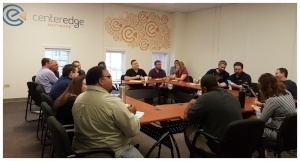Last week, we discussed some of the culture initiatives that we’ve implemented at CenterEdge, and that resulted in our newly defined core values. If you missed it, get PART ONE. Once we articulated and defined our values, we then needed to roll them out with the team. Without intention, stating your values is just a conversation – hardly a culture revolution. And it’s a process that keeps evolving over time. Although there are several ways you can roll out your own values training, these are the steps we’ve taken to implement a culture where these values reign supreme.
We scheduled and held training sessions with all our team members to introduce the core values. It’s best if you can do these with your entire staff at one time, so everyone is part of the same message. That wasn’t possible for us due to phone and work coverage, and I’m sure many of you can relate to that. Because of that, we scheduled multiple sessions, and made sure that each session had multiple departments in it. This is very important in order to build camaraderie between departments, and something that I’ve seen missing in many family entertainment establishments. I’d go so far as to ask team members to sit by someone they don’t know as a way to build bonds across departments.
Once you’ve got the team together, it’s time for the fun! And that is a key element of any session like this. It’s not a roll out of new “rules, ” so a session of this nature must be lively, interactive and carefully executed in order to get team member buy in. A few tips:
- Make the values come alive for the individual team member. To do this, we used a sharing activity where we each talked about a personal core value. We shared them in small groups and posted the results on sticky not
 es on the wall. As a large group, we reviewed each one, asked the team member to elaborate on his stated value, and then put them into four categories (categories, you might have guessed, that aligned within our new company values). This enabled us to show two important things: 1) that our company’s values were in line with our team’s personal ones and 2) that, as individuals, we’re really not that different from one another. This can help us to feel and show empathy for others when we face challenges and difficult situations – a must in any business.
es on the wall. As a large group, we reviewed each one, asked the team member to elaborate on his stated value, and then put them into four categories (categories, you might have guessed, that aligned within our new company values). This enabled us to show two important things: 1) that our company’s values were in line with our team’s personal ones and 2) that, as individuals, we’re really not that different from one another. This can help us to feel and show empathy for others when we face challenges and difficult situations – a must in any business. - Elicit key behaviors that the team will demonstrate when they are living each of the core values. For example, when I am being a partner, I might be proactive to ask others if I can help them. And go one step further to discuss those behaviors that we sometimes, consciously or not, exhibit that violate those values. If I lose patience with my colleague (or my client), is that being a good partner? This helps us to recognize and acknowledge each other when we are winning, and to coach each other when we’re not.
- Offer Crucial Coaching Tips – if you want the team to really adopt the values, you’ve got to give them the tools to reinforce them. Discuss a way for the team to recognize each other. We created a channel inside our instant messaging portal for peer to peer recognition, it’s called #kudos. One great thing about using our messaging system is that we all see the recognition, and can then comment in support of the feedback. One of the most impactful ways I’ve seen this in action happened when a team member, Andrew, was recognized by a client for being a real problem solver during their install. The feedback was captured and sent out to the team where it was immediately met with pats on the back for Andrew. But he didn’t keep the recognition just for himself; instead he immediately shared it by replying, “the real kudos goes to the man behind the scenes, Alex.” THIS is what being a partner is all about! In addition to sharing the successes, we also needed to discuss how to help hold each other accountable for less than stellar behavior. We discussed the way to give it privately and respectfully and also how to receive criticism. We all agreed that, though it might be difficult, we were committed to talking about the good, the bad, and the ugly.
The sessions were fun and motivational, according to all the feedback, but the work doesn’t end there. Little by little, you have to encourage change. The more you talk about your company’s values, the more they become part of your culture. In the two months since we’ve rolled them out, we’ve had about 20 instances of team members praising each other (with dozens more pats on the back from the rest of the team witnessing the recognition), and several team members reached out directly to say that they’ve seen a real change in the overall feeling of our office. Pretty exciting!
One last thought that needs mentioning. I call it the “So What” Factor: Don’t ask questions for which you aren’t prepared to deal with the answers. Meaning, asking for feedback and doing nothing with it breaks trust and makes a team feel, at best, ignored and, at worst, betrayed. As a leader, it’s your job to be the change. Listen and learn what needs to be done to improve efficiency, processes, and work dynamics. That doesn’t mean react to every idea for improvement, but acknowledge, examine, and determine next steps. In our focus group we learned that we want to think of clients and each other as family. And we also learned that we sometimes don’t show that in the way that we talk to each other or in interdepartmental communications. After that initial session, we took the feedback to the management team who addressed the challenges and created next steps. They did so transparently and we followed up later with the focus group to share the outcomes. (These included increased communications, our first ever All Hands Meeting, and even office rearrangement!) Be ready for the feedback because, although it can be painful, it’s a crucial piece necessary to grow your organization.
So what do you think? Is this something you’d like to try to boost morale, teamwork and service to your guests? Tell us how you carry out your culture and values by commenting on our blog, social media, or sending feedback or questions to clientsuccess@centeredgesoftware.com. Best of luck!
Search Resources
Subscribe to Email Updates
Featured Resources
News //
CenterEdge Now Integrates with PourMyBeer to Help FECs Serve Up Success

News //
ClawCADE is Newest Concept for Fast-Growing Family Fun Brands

Blogs //
Data-Driven Decisions: Using Management Software to Optimize Staffing & Guest Flow

Blogs //
How to Stay Productive When Your To-Do List Feels Out of Control: A Guide for FEC Owners & Operators

Posts by Topic
- Advantage Payments (7)
- Brand Management (19)
- Business Growth (81)
- Capacity Management (2)
- CenterEdge News (28)
- Client Interviews (8)
- Credit Card Processing (3)
- Data & Reporting (12)
- Digital Signage (1)
- Event Management (20)
- Facility Management (10)
- Food & Beverage (8)
- Guest Experience (34)
- Guest Management (20)
- Holiday Season & Promotions (5)
- Industry Events (10)
- Inventory Management (1)
- Loyalty Programs (8)
- Marketing Tips (24)
- Operations (1)
- Point of Sale (10)
- Product Launch (11)
- Productivity (5)
- Profitability (35)
- Redemption Management (1)
- Sales (35)
- Season Passes (1)
- Team Training (60)
- Waivers (2)

Leave a Comment